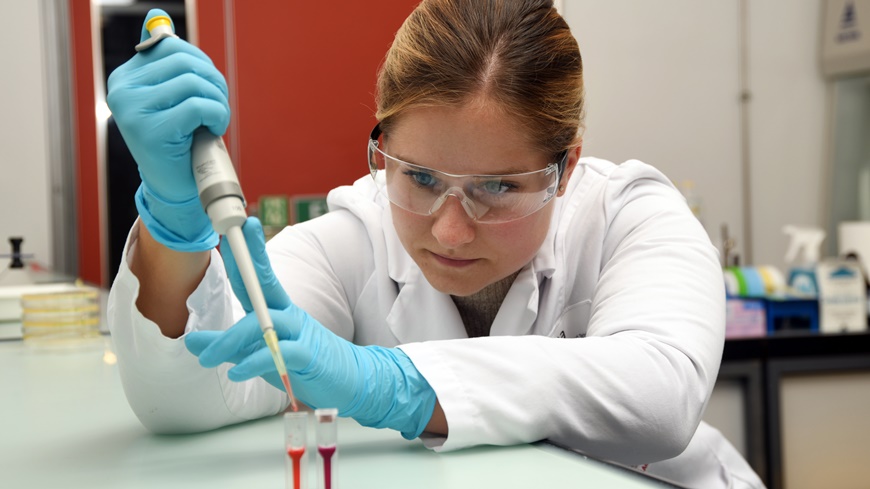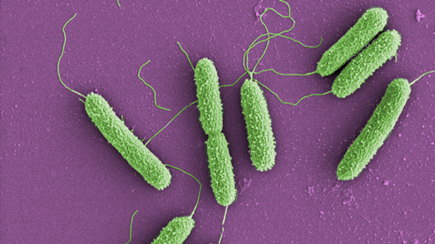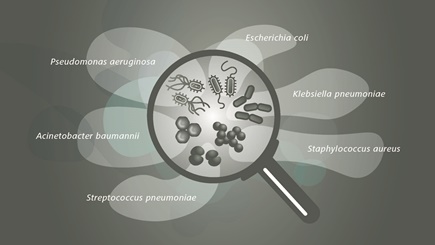Dangerous increase in antimicrobial resistance
Sensors against superbugs
Antibiotic-resistant bacteria can cause life-threatening infections that are almost impossible to treat with existing medication. As a result, common illnesses such as urinary tract infections or skin wounds are becoming a health risk. Empa researchers are therefore working on sensors that quickly identify resistant germs and recommend efficient treatment.

The spread of antibiotic-resistant superbugs is plunging health care worldwide into a crisis. It is estimated that the number of victims of multi-resistant bacteria in 2028 will be as high as before the discovery of penicillin 100 years earlier, with costs running into the billions. The World Health Organization (WHO) calls the “silent pandemic” one of the greatest threats to global health.
The development of resistance is fueled by the hasty use of antibiotics without the underlying pathogen having been identified beforehand. This is not entirely incomprehensible: Precious time is lost during diagnosis using time-consuming methods, so that in emergency situations, for example, it is often decided not to wait for the relevant laboratory results. The possible outcome: The treatment remains ineffective, and the risk of further resistance development increases. Empa researchers are therefore working together with clinical partners on innovative diagnostic tools such as sensors that can detect resistant pathogens faster and allow customized treatment in good time.
Light sensor indicates pneumonia

Multidrug-resistant bacteria are particularly common in hospital-acquired infections such as pneumonia. One pathogen that can cause such pneumonia is Klebsiella pneumoniae. Empa researcher Giorgia Giovannini from the Biomimetic Membranes and Textiles laboratory is currently working with the Cantonal Hospital of St. Gallen to develop a sensor for this superbug that emits fluorescent light when a Klebsiella infection is present.
The sensor reacts to the enzyme urease, which the bacteria produce. In the "Doorstep" project, the researchers are working on polymer particles that surround a fluorescent dye. If the bacterial urease decomposes the polymer, the dye can develop its luminosity. The diagnostic method should work with a throat swab or a sputum sample. This would make it possible to identify the pathogens causing pneumonia within a few hours instead of several days.
Plaster warns of wound germs
Infected wounds are also an important area of application for the rapid and precise diagnosis of resistant pathogens. They not only cause pain and tissue damage – they are also a breeding ground for antibiotic-resistant superbugs. A team led by Empa researchers Luciano Boesel and Giorgia Giovannini is now launching a project together with the Cantonal Hospital of St. Gallen in which they want to develop a multi-sensor wound dressing. It is based on silica nanoparticles embedded in a resistant hydrogel made from biocompatible polymers. The sensor technology is to be integrated directly into the dressing material. The nanoparticles are functionalized with substances that can specifically indicate the metabolites of certain bacteria.
The sensors are designed to react to particularly dreadful wound pathogens such as Staphylococcus aureus and indicate a change in the acid-base balance in the wound. Moreover, they should indicate the risk of antibiotic resistance. As highly pathogenic wound germs are equipped with a specific enzyme, beta-lactamase, which they use to inactivate certain antibiotics, the sensor contains dyes that are broken down by this enzyme. If resistant bacteria in the wound produce the enzyme, the sensor gives a clear warning by glowing under UV light. In everyday clinical practice, the wound sensor thus enables rapid, cost-effective diagnosis and personalized wound treatment. The project could be launched thanks to generous donations from the Philipp and Henny Bender Foundation, the Blumenau-Léonie Hartmann Foundation, the Hans Groeber Foundation and the Räschle Foundation.
Focus on bacteria

The number of multi-resistant bacterial species is constantly increasing. Bacteria that lead to deaths due to antibiotic resistance include Escherichia coli, Staphylococcus aureus, Klebsiella pneumoniae, Streptococcus pneumoniae, Acinetobacter baumannii and Pseudomonas aeruginosa. Incorrect and excessive use of antibiotics accelerates the spread of superbugs. In 2019, such pathogens were linked to around five million deaths. The World Health Organization (WHO) has therefore declared them a priority for research and development. Illustration: Empa
Easy detection in urine samples
Another nasty member of the bacterial kingdom is Pseudomonas aeruginosa. This rod-shaped bacterium can cause various diseases, including infections of the urinary tract, for example via urinary catheters during a hospital stay. And these pathogens are often resistant to various antibiotics. A team of researchers from Empa and ETH Zurich has therefore developed a method using magnetic nanoparticles that detects the bacteria quickly and precisely. As the magnetic particles are coupled to protein building blocks that react exclusively with Pseudomonas aeruginosa, the bacterial cells can ultimately be specifically “fished” out of urine samples using a magnetic field.
In the next step, the sensitivity of the pathogens to various antibiotics is analyzed using a chemiluminescence method. If there are resistant bacteria in the test tube, the sample emits light. However, if the germs can be killed with antibiotics, it remains dark. “All in all, the resistance test takes around 30 minutes – compared to several days for a classic cultivation of bacterial cultures,” says Qun Ren, group leader at Empa's Biointerfaces laboratory in St. Gallen. This makes it possible to determine the appropriate antibiotic therapy within a short time – and thus prevent the development of further resistance.
Empa's Zukunftsfonds
Empa's Zukunftsfonds is looking for private donations for outstanding research projects and talents that are not (yet) supported elsewhere.
If you would also like to make a contribution to the project, you can find our donation form here.
Dr. Luciano Boesel
Biomimetic Membranes and Textiles
Phone +41 58 765 73 93
Dr. Qun Ren
Biointerfaces
Phone +41 58 765 7688
Antibiotic resistance affects people all over the world. Fewer and fewer effective drugs are available to combat resistant bacteria.
This is why Empa is researching new therapies and diagnostic methods. In the recently launched Research Booster Antibiotic Resistance, several Empa laboratories are working together with hospital partners on an interdisciplinary basis in the fight against the “silent pandemic” in order to advance the diagnosis, treatment and prevention of infections with antibiotic-resistant germs.
Empa's research booster on antimicrobial resistance
Loris Pandiani
Empa Zukunftsfonds
Phone +41 58 765 47 03
F Pan, S Altenried, S Scheibler, AHC Anthis, Q Ren; Specific capture of Pseudomonas aeruginosa for rapid detection of antimicrobial resistance in urinary tract infections; Biosensors and Bioelectronics (2023); https://doi.org/10.1016/j.bios.2022.114962
WC Albrich, CR Kahlert, S Nigg, LF Boesel, and G Giovannini; Fluorescent Probe for the pH-Independent Rapid and Sensitive Direct Detection of Urease-Producing Bacteria; Analytical Chemistry (2024); https://doi.org/10.1021/acs.analchem.4c05182
-
Share






